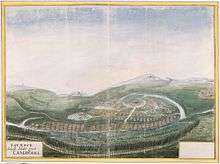Longvek
Longvek or Lavek[lower-alpha 1] (Khmer: លង្វែក pronounced [lŭəŋ.ˈʋɛːk] or ល្វែក pronounced [lʋɛːk]; meaning "intersection" or "crossroads") was a city in ancient Cambodia. It was the second capital city during the Cambodia's Middle Ages which began after the Khmer Empire's Angkor Era.

Longvek was chosen by King Ang Chan I (Ponhea Chan) after the sacking of Angkor by the Siamese as a new capital because of its more readily defensible terrain. As a result, there was a time when Cambodia was often referred to as Longvek by foreign travellers.
After Ang Chan I defeated Sdach Kon he changed the capital city from Chaktomuk to Longvek in 1528. This new city was the capital of the Kingdom of Cambodia from 1528 to 1594. This city was sacked by the Siamese (Thai) in 1594 and then the Thai king chose his son to reign over Cambodia in 1594. Longvek was one of the greatest cities in Cambodia.
History
During the 14th and 15th centuries Cambodia was in a state of eclipse. Following the almost total destruction of Angkor, Longvek was chosen as the new capital of the now minor state of Cambodia. Longvek was located halfway between Phnom Penh and the southern end of the Tonle Sap and it was chosen by King Ang Chan (1516–66) as his official capital. King Ang Chan ordered his palace to be built in Longvek in 1553.
Longvek became the nation's capital in the 16th century after the civil war between Ney Khan and Ang Chan I. After Ponhea Chan's victory, he became the new king of Cambodia.
Spanish and Portuguese adventurers and missionaries, like Blas Ruiz de Hernán González from Ciudad Real, first visited the kingdom during this period. Blas became a friend of King Satha of Longvek, who was well-disposed towards foreigners,[1] and while in the kingdom got to know Portuguese adventurer Diogo Beloso from Amarante. The Iberians referred to Phnom Penh as "Churdumuco" and to Srei Santhor as "Sistor".[2] Not long thereafter Longvek was invaded by the Siamese ruler of Ayutthaya.[3]
King Naresuan of Siam conquered Longvek in 1593.[4]:143 This conquest marked a downturn in the kingdom's fortunes. In the historical period that followed Cambodia became a pawn in a power struggle between its two increasingly powerful neighbours, Siam and Vietnam.
In 1618, the capital of Cambodia was once again relocated and was moved to Oudong.
Notes
- Variations of the name include: Lvek, Laṅvēka, Luṅvēka, Lovek, and Eauweck.
References
- Trudy Jacobsen, Lost goddesses ISBN 87-7694-001-2 ISBN 978-8776940010
- The Philippine islands, 1493-1803
- Miguel de Jaque de los Rios Manzanedo Viaje de las Indias Orientales y Occidentales (Año 1606)
- Rajanubhab, D., 2001, Our Wars With the Burmese, Bangkok: White Lotus Co. Ltd., ISBN 9747534584
Bibliography
- Ben Kiernan, Blood and soil ISBN 978-0-300-10098-3 ISBN 0300100981
- Sanjay Subrahmanyam & Marie-José Capelle, L'Empire portugais d'Asie, 1500–1700; Histoire politique et économique. Maisonneuve & Larose (1999) ISBN 2-7068-1252-4 ISBN 978-2706812521